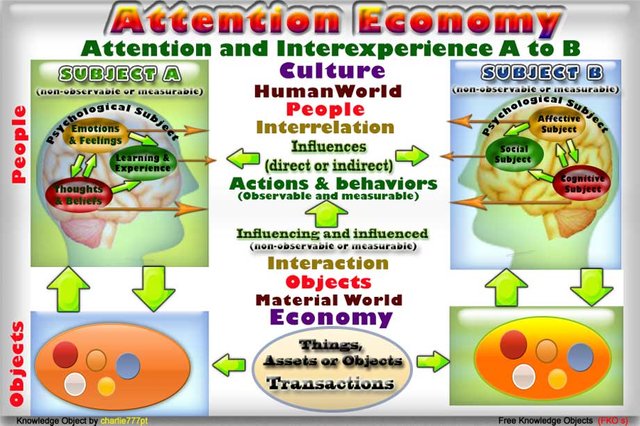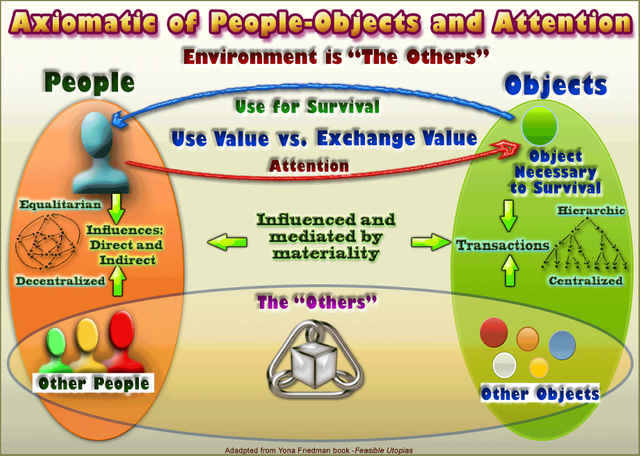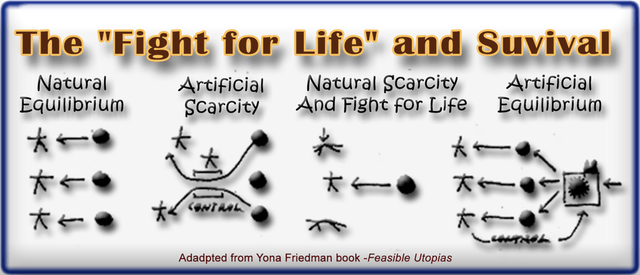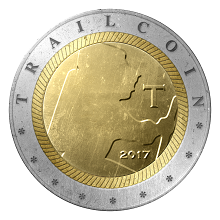Can Steemit attention-economy be a "non-competitive" society?
"Can Steemit attention economy be a non-competitive society?"
Introduction
My next post is called "Blockchain:"The rise of a Non-Competitive Society and the Importance of "Importance"made possible with the singular technology of the blockchain and decentralized applications.This allows one of the most important factors of making people equalitarian, by the continuous feedback that allows people's actions and behaviors to improve their attention, attraction, retention, and participation in the community.
In my last post Can Steemit be a Gandhi Phenomena?, uses the line of thought of Yona Friedman an utopist and anarchist that had a very good knowledge of sociology physics and science communications at the time he published about this subject (1975).
I talked about the numbers the number constraints of the "critical-group" in environments, a form of social ecology as a self-regulating mechanism in big organizations.
This form of social selection depend on the system rules to maintain a society - a situation common to all genetic species (animal or man).
This post continues to follow the theory of Yona Friedman and is trying to bring light to the problem of the relations between man always mediated and influenced by the world of objects.
I'll make a little introduction to the new concept of "Attention-Economy" in people and in the ecosystem and the culture of social networks.
The blockchains and Steemit are vehicles for the emergence of a very still intangible utopias of all times - an equalitarian society in the relations of People and a non-competitive society in relation to property or objects.
"Society have a materialistic base and human consciousness is a reflection of that." charlie7777pt
To start I would like suggest to read my other related posts , Do Blockchain communities have a "Critical-Group" ?, Is the blockchain a "Hierarchical" or an "Equalitarian" Community?, Is the blockchain a Realizable Social Utopia?, for a better understanding of the frame of the theoretical mathematical model that any observer can use to measure societies as man and objects inside structures (Hierarchical or Equalitarian ) with people interacting and influencing people and interrelating with objects (things).The fundamental objective of the post-scarcity economy and the post-truth era is people's education on the value of their attention and the principles of attention economy as well as the right to privacy.
Attention economic theory defines human attention as a resource or scarce commodity and is inversely proportional to the creation of information in the ecosystem as a constant that can be expressed on the formula: Information Overload = Scarcity of Attention
For example an important factor analysis on the attention-based economy of Steemit would be focused and measured by the number of "eyeballs" on content.
My objective is to help to open discussion and philosophical reflections on the path of steemit community to be the best model of social media-based economy attention and dedication on the blockchain, as well as a support equalitarian little groups collaborating for crowd creativity working in open innovation.
What are the components of the concept of Attention in each person in the blockchain "e-eco-nomics".?
We are being increasingly bombarded by information like for example the number of daily messages is passing the 5000 but the human brain has limited capacities to absorb it and as a result, people is creating natural defenses to filter this excessive fluxes.Recent studies show that with the overflow of information and the Internet, the Attention Span time is decreasing from 12 mins to 7 secs in 10 years.
So even attention is the most scarce asset on the post-scarcity era:
Reduced Attention = f (exponential Growth of information).

The components to think about individual and collective attention for me are :
Emotions & feelings==>(Emotions Affective component ---> Non-observable or measurable.
Thoughts & Beliefs(Attitudes)==>Cognitive component --->Non-observable or measurable.
Actions & behaviors (Socialize)==>Social Component - The praxis of people --->Observable and measurable.
Culture & Economy ==>Personal Inter-experience - Component Interaction with people interrelated and mediated by objects (property) --->Non-observable or measurable.
Influences ==>Social attention as collective attention. --->Non-observable or measurable. Have a strong unconscious component.
1- Environment is "The Others" - The Axiomatic of Peers and Objects
Society and environment have the same meaning: People and objects linked between them by "The Others" that are always totally different for each one involvedIn this case objects are considered "means to an end", an element of reality without self-goals opposed to people that are goal-oriented.
I state the difference here because objects in actual society are still hierarchic (paternalism admissible) but in the relation of human2human they can be already equalitarian (paternalism inadmissible).
To keep people equalitarian, the structure they are using must always favor ways for the diffusion of all the possibilities of change, discussion and constant feedback of their actions and give access to all the stakeholders of equal rights in the mechanism of influences (man and objects).
The inter-experience between peers is based and limited by the following factors:
1 - Individual intentions in peers inter-relation;
2 - Number of objects and people;
3 - Infrastructure is people and objects in a system and the influences propagating on it;
Influence propagation depends on the problem of access as a function of:
a) Referenced and limited period of time;
b) Valency - valency is an observable property of "animal man" that expresses the limit of the number of centers of interest a person can focus attention , limiting the number of people that can receive and transmit influence in a period of time;
c) Number of elements in a system (men and objects);
Access besides the technological frame is conditioned by time and genetic capabilities of the species, a limitation in the number of people each one can comunicate and the number of objects we can manage and transact, consequently conditioning the numbers of man and objects in the small equalitarian groups.
The axiomatic of people-objects and attention

The Inter-expeience between peers is the inter-relationism(people2people) and interactionism(objects).
In my point of view the inter-experience is based in dialectic in the value of objects as use value (utility or usability) and exchange value expressed in the price, when transactions takes place in the transmission of the proprety of objects in the relations of people.
2- The organization of "The Others"
The First axiom of links between people and objects
a) - One object belongs to the environment if one person gives attention to it.b) - Necessary objects for the survival of a person drives the attention.
c) - Any attention a person gives to an object always give attention to the relation between the object and the others.
Corollaries
(1) - Environments are different for different people depending on the individual attention capabilities.(2) - Attention is the function that generates Links.
(3) -Without attention, there is no survival.
(4) - The difference between people (with goals) and objects (without goals) is as well a different type of attention.
The Second Axiom of Organization
(a) - Attention is born from dissatisfaction in a situation.(b) - Survival makes us move to change it.
(c) - Attention is focused between the links of the situation and the others.
This second axiomatic is still based in one of the fundamental pillars and values of society- property- that is related to usability and scarcity.
(i) - Man can't do anything with Objects except use them;
(ii) - Usability depends on the other consent;
(iii) - Consent and use can be "transacted"
The concept of simultaneity in objects usability makes an axiom of uses cases:
(i) - One person vs one object.
(ii) - One person vs several objects.
(iii) - Several persons vs one object.
(iv) - Several persons vs several objects.
After this we have:
1- One person can use one object (exclusively or simulatneously with others)
2- The consent that allows the usability.
(a) - require other person's attention.
(b) - escape the attention of the others.
3- Usability of an object is transferable:
(a) - with consent of others.
(b)- without others's consent.
3 - Is the "Fight for Life" and Survival necessary?
Yona Friedman in his analisys of a "non-competitive society" first poses the question of the concept of "Fight for Life" in the individuals of any species and he illustrate it by the story of the dogs and bones and establish some axioms.(i) - 2 Dogs- 1 bone => Fight=>winner take the bone ---> If the nr of objects is superior to the number of people (scarcity) they try to anulate the excess of people and equlibrate with the number of objects.
(ii) - 2 Dogs - 2 bones => (i) - Fight=>winner take the 2 bones or => (ii) no fight=> each dogs = 1 bone ---->(natural or artificial bondance). If there is equlibrium objects=people there is no need to eliminate the supernumerary
(iii)- 2 Dogs - 200 bones => (i) possible fight=> winner takes the right of precedence to eat over the other.----------If there is equlibrium objects>people=people there is no need to eliminate the supernumerary but its possible that a fight to determine the order of access to the Objects (Precedence).
We can conclude that the "Fight for Life" it is only necessary in the first case, it is artificial manipulation of the equlibrium in the second and third case can happen in 4 ways:

a) - Natural abundance= (Objects= nr of People)==> Equlibrium ----> is a natural social selection mechanism of the ecosystem.
(b) - Natural abundance = Induced artificial scarcity==> a group of people with the will for Power tries to control the access to the objects (strangulate) making "artificial or false scarcity" as a tool for power.
c) - Natural Scarcity = (nr of Objects< nr of People) ==>"Fight for Life" - to reduce the number of people.
d) - Natural Scarcity and Technological solutions==> Objects produced industrially to increase the number of objects instead of reducing the number of people with the attention focused on the object.
So the" Fight for Life" is not necessary in the case a) and b) but in this one, the scarcity is provoked by the ones that want to have power unless the technology and production are collective property. In the c) and d) case, natural and artificial scarcity will always lead to "Fight for Survival".
3- The Fight for Power dominance(precedence)
Artificial induced scarcity is the genesis of inequality in the world and leads to the elimination of the exceeding people in relation to the number of objects.In this case, both scarcities can be tools to achieve power using fight(force), controlled production or technology owned oligarchy.
The natural equilibrium of objects= people seems to be the only way for total equalitarian communities.
Natural equilibrium (or non-organization) is the dream of all utopists but is still a romantic dream of a dystopia, a non-realizable utopia for now, because society is increasing artificial scarcity and artificial attention generating more fight for survival.
Natural scarcity is missing objects for survival , but artificial scarcity is an invention of objects not necessary for survival but only used as a "Distinction".
If they where abundant they wouldn't be necessary for survival and would lose the value of the "distinction".
False Scarcity have a good example of the the "social status" elevation as a rarity that wouldn't be desired if it was not scarse.
In this view artificially created scarcity is the worst plague for Humanity because people are still stuck in unawareness and can't run away and refuse this invented or fallacious value, introducing competition even in abundance.
The society of non-competition is any community that suppresses "artificial scarcity";
Nobody needed Steemit (or maybe Steem in this case) until it was invented creating an artificial scarcity in relation objects the new attention economy.But steemit created a sanctuary or refuge for the exponential information overload of traditional social media of meaningfully content for 7 seconds attention span and made a singular space where all people can be equal in the relation of man2man and influence of the destiny of the platform with equal rights.
So in relation to people Steemit and the blockchain can still be equalitarian (equality between people), but in relation to objects, it will always be hierarchic and paternalistic because steem or bitcoin or any object where created as artificial induced scarcity needed for the survival of all Man.
Steemit, as one artificial induced scarcity in relation to objects but it can be the cradle in the blockchain to reduce the Gap of Inequality in the world of objects and maintain the path for a flatter equilibration in distribution and equalization.
The societies of non-competition are essentially small communities(that are interconnected by the same goals) with equal rights to access and communication.
A group of non-competition can only exist if there is a natural or artificial equilibrium of the objects needed for survival but the only possible condition for non-competitive Steemit had to be collectively owned equally by all the Steemians.
In my next post will try to explain better the concept of attention economy that creates conditions to establish visions for the emergence of the biggest Utopia of all times a "non-competitive society" and to clarify the definition of the future of the Attention-Economy as an Attraction/Retention Economy and a Participative Economy.
Utopia, after all, as Victor Hugo once said, "is tomorrow’s truth"
Social media networks on the blockchain are facilitating and increasing channels for attention distribution and filtering and solve the problems of comunication, coordination, cognition, and collaboration between small free cells of equalitarian groups.The Participative Economy is about the structure of the community, the processes of learning by co-creation and innovation in collective action, supported by open and p2p communication and transactions.
Footnote:
(*) I choose the term Equalitarian for a vision that accepts or promotes the view of equalitarianism , instead of Egalitarian a vision who accepts or promotes social equality and equal rights for all people because that is not yet possible in the material hierarchic structure of our world of objects and assets.My other posts on Steemit about the blockchain and Realizable Utopias
Can Steemit be a Gandhi Phenomena?Do Blockchain communities have a "Critical-Group" ?
Is the blockchain a "Hierarchical" or an "Equalitarian" Community?
Is the blockchain a Realizable Social Utopia?
An Ode to the blockchain - the Dialectic of Liberation
Steemit Value : Intangible Asset vs Tangible Asset Analysis
Steemit: Altruism and Financial Scarcity and the rise of Advertising
Steemit : The Shrinking of the Money Pie and the Rise of Human Pie
B/W Pictures Source:
All black and white hand writing pictures included in the slides, are originally copied from the book - "Utopias Realizáveis" - (Realizable Utopias )by Yona Friedman , Sociocultur, Lisbon, 1977 (in Portuguese) .
References:
(1) Yona Friedman - wikipedia : Architect, urban planner, designer but also a sociology student, physics and science communications, Yona Friedman (Budapest, 1923) is back at the center of international architectural culture after having long been dismissed as Utopian.
Member of the Hungarian anti-Nazi resistance, Friedman spent a few years in Haifa, Israel, where he sketched the first of his many theories, namely the Mobile Manifesto architecture in which special construction systems allow the inhabitant to determine for itself the shape, style etc. his apartment and to change it when they want it.
website: Yona Friedman
Interview with Yona Friedman: "Imagine, Having Improvised Volumes "Floating" In Space, Like Balloons"
Yona Friedman 1000+ photos - Pinterest
Web Links
Attention economy - Wikipedia
Books:
Utopies réalisables by Yona Friedman
Comment vivre entre les autres sans être esclave et sans être chef, J.J. Pauvert, Paris, 1974.
The Politics of Utopia: A Study in Theory and Practice By Barbara Goodwin, Keith TaylorOne Video among hundreds : Yona Friedman: You are obliged to stay Mainstream.
Hello @charlie777pt,
Congratulations! Your post has been chosen by the communities of SteemTrail as one of our top picks today.
Also, as a selection for being a top pick today, you have been awarded a TRAIL token for your participation on our innovative platform...STEEM.
Please visit SteemTrail to get instructions on how to claim your TRAIL token today.
If you wish to not receive comments from SteemTrail, please reply with "Stop" to opt out.
Happy TRAIL!

Very interesting article, thank you for creating. I would be interested in discussing with you if a truly equalitarian society can exist, while the considering the condition of man.
Thanks a lot for your comment.:)
Well, today as I say in my posts it is possible to create equalitarian freedom cells where man all have the same rights of access, everybody knows and participate in the construction of the future and have the same opportunities.
In relations to objects(possessions or property) is not possible yet - its the next Utopia that we help to turn into reality
Crypto-currencies are an example of one Utopia that came true in reality that makes all men equal in terms of access, usability, and collective ownership.
In the other way, it proved that banks and financial institutions artificially invented scarcity to control the supply chain of money.
But it didn't solve the problem of objects because all man have different quantities of coins and nobody wants to redistribute and equalize their possessions.
Objects (the sense of property) are still the only obstacle to a non-competitive society.
Absolutely all valid points. The next ten years will certainly be a fascinating time to be alive.
Yes :), no doubt and we are surfing the waves of the future.
Let's make realizable the most difficult and almost impossible to Utopia of all times.
This is an excellent read @charlie777pt. I hope I will have a chance to post something to this topic soon. In the meantime, just have to say that blockchain (or as you say “Steemit attention-economy”) doesn't need to create a "non-competitive" society, but a society of helthy competition, which is not possible inside the hierarchical-capitalist matrix. Capitalism can only produce violence on the fundament of unhealthy competition:
You can start reading his book from here:
https://steemit.com/philosophy/@lighteye/the-last-revolution-part-22
Thanks for your the boom in my self-esteem.:)
Like you steemit is not a non-competitive society, but it can be the cradle of an experience on the blockchain, that can pave the way for the future of a healthier competition, with a flatter pyramid distribution in the world of objects and support the ones that didn't bring monetary value in, but make value on Steemit with their reputation(participation).
Now everybody can join hands in small freedom cells, to drive steemit in the best way for everybody because attention and participation are the pillars of equalitarianism.
Very good post, upped your comments...
Thanks for reading, upvoting and commenting.:)